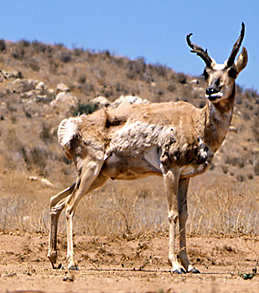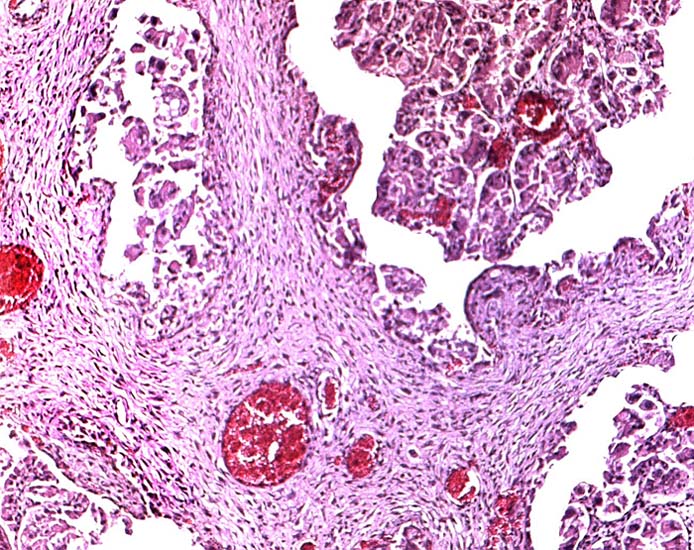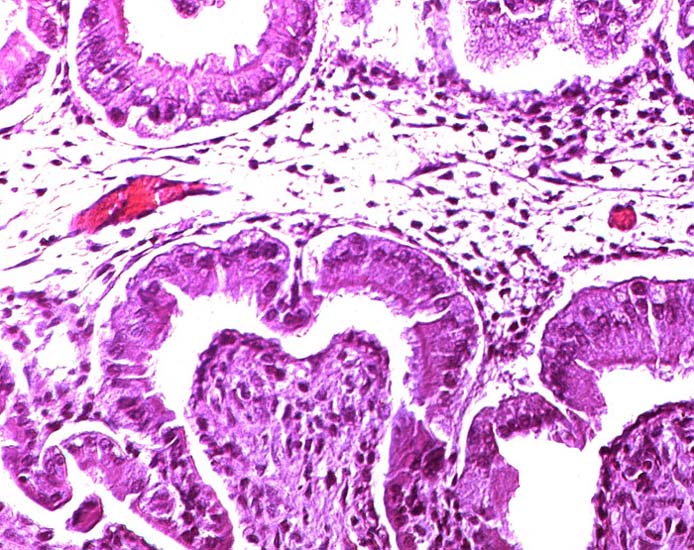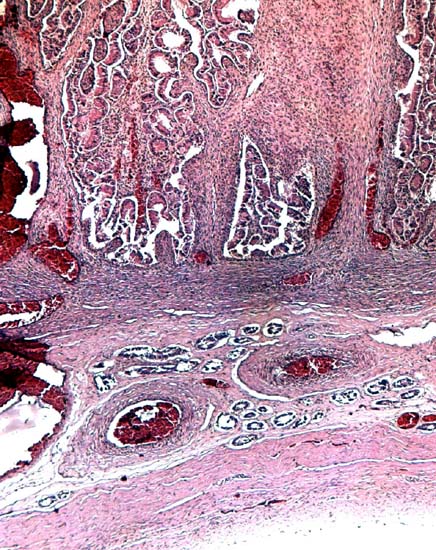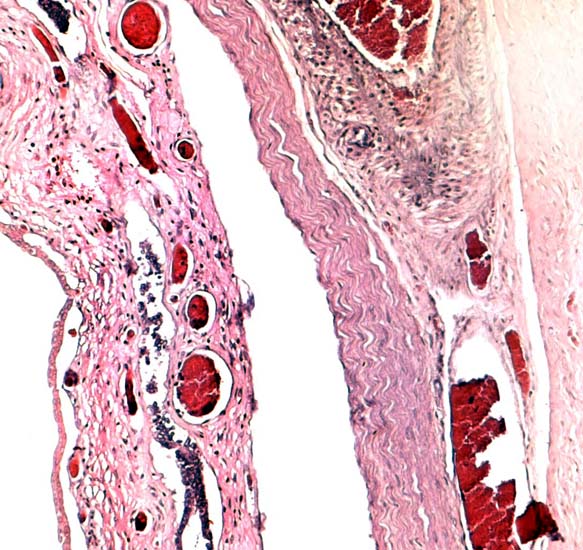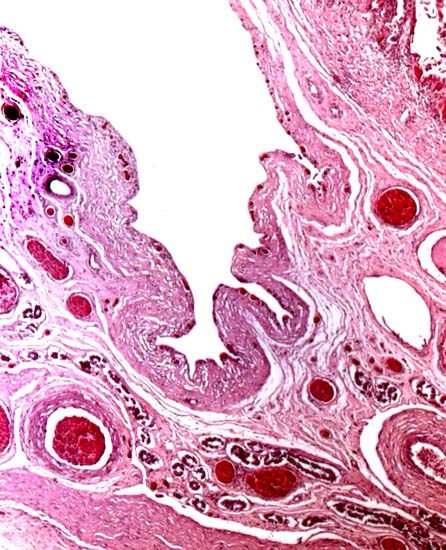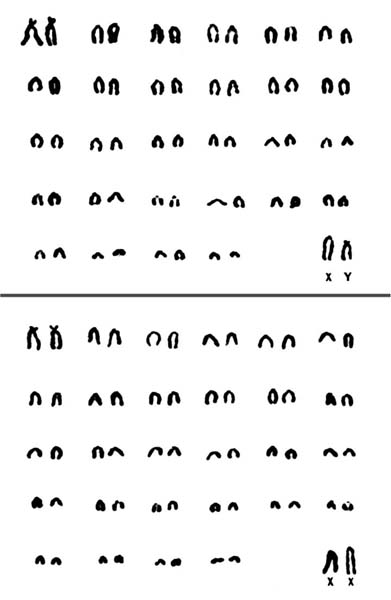14) Immunology
The serological studies conducted are listed in the next section.
15) Pathological features
O'Gara (1969) depicted a "teratomas" which I believe to be more likely an acardiac fetus (his fig. 17). In personal communications with the author I learned that another observer had identified several same-sex pronghorn twin fetuses with vascular anastomoses of their placental circulations, suggesting that MZ twins may occur; thus, acardiacs would be a good possibility. Griner (1983) autopsied 25 pronghorn and the difficulty with immobilization is shown in his data. "Lumpy jaw" and various infections, as well as "white muscle disease" were other causes of death. He also saw one squamous cell carcinoma of the oral mucosa with metastases. Experimental high selenium diets had no significant impact on captive pronghorn (Raisbeck et al., 1996). An apparent copper deficiency in hand-reared fawns disappeared after copper supplementation (Miller et al., 2001). Polioencephalomalacia in some Saskatchewan wild pronghorn (after grain ingestion) was attributed to thiamine deficiency by Wobeser et al. (1983).
Numerous studies of infectious agents have been undertaken in captive and wild pronghorn. They can be separated into three categories:
1) Parasites: Dubey (1980; 1981) identified Sarcocystis and Toxoplasma in pronghorn. Kuttler (1984) found Anaplasma marginale. Kingston et al. (1990) identified Entamoeba bovis in the feces of pronghorn fawns. Simmons et al. (2002) identified natural infection with Parastrongylus tenuis in four captive animals of Nebraska that led to euthanasia.
2) Viruses: Stauber et al. (1980) surveyed for antibodies in 104 adult and 42 fawns and found antibodies to bovine infectious diarrhea, infectious bovine rhinotracheitis, parainfluenza, bovine adenovirus 7 & 3 and anaplasma, but none to brucella, bluetongue or epizootic hemorrhagic disease. Jessup (1985) studied antibodies against two orbiviruses (bluetongue) and found it uncommonly. Bluetongue infection, however, caused epidemic losses in Wyoming during epidemics of 1976 and 1984 (Thorne et al., 1988). Infection by mosquito-borne Malpias spring virus was demonstrated by Clark et al. (1988). A survey of antibodies to malignant catarrh fever virus in several ruminants by Li et al. (1996) found none in pronghorn but it was present in several other wild ungulates. A large outbreak of epizootic hemorrhagic disease killed numerous pronghorn (Brodie et al., 1998). Experimental infection with contagious ecthyma virus yielded oral lesions but had only a "limited clinical response" and was not thought to impact wild populations (Lance et al., 1983).
3) Bacteria: Griner (1983) already indicated losses from salmonellosis. Deaths due to infection with Pasteurella multocida has been reported from Oregon and Montana (Dunbar et al., 2000). Brucella abortus found in Yellowstone bison rarely colonizes pregnant pronghorn according to the survey by Elzer et al. (2002). An important description of fusobacteriosis comes from Edwards et al. (2001). These recently captured animals were housed in a pen previously used by cattle. Following a rain, pododermatitis developed with rapid sepsis due to Fusobacterium necrophorum ensuing.
16) Physiologic data
Hand-rearing and study of nutrition were studied in considerable detail by Schwartz et al. (1976). Diarrhea and joint problems were major side effects of some diets. Because of significant declines of pronghorn populations in Oregon, Dunbar et al. (1999) studied numerous parameters of fawns and adult animals, without finding a significant change to explain the decline. Baker et al. (1998) studied diet supplements and their digestive efficiency of several American ruminants, including the pronghorn. Hematologic values and blood chemistry were studied by Clemens et al. (1987). Pronghorn were found to have significantly higher selenium levels than bison and deer. Problems with tranquilization of pronghorn were amply studied by Pusateri et al. (1982) who found dosing with diazepam and promazine-HCl difficult. In efforts to find a "model" for the study of sickle cell disease, Dhindsa et al. (1975) studied sera of deer and pronghorn. They found low alkaline phosphatase levels in pronghorn. Mossman & Duke (1973) stated that the ovaries of pronghorn do not differ much from other ungulates and depicted (their fig. 6.98) the two types of luteal cells they identified.
17) Other resources
Cell strains of fibroblasts are available from CRES at the San Diego Zoo by contacting Dr. Oliver Ryder atoryder@ucsd.edu
18) Other remarks - What additional Information is needed?
Timing of implantation and early microscopic studies are needed, as well as endocrine studies.
Acknowledgement
The animal photograph in this chapter comes from the Zoological Society of San Diego. I appreciate also very much the help of the pathologists at the San Diego Zoo.
References
Baker, D.L., Stout, G.W. and Miller, M.W.: A diet supplement for captive wild ruminants. J. Zoo Wildl. Med. 29:150-156, 1998.
Beintema, J.J., Breukelman, H.J., Dubois, J.Y. and Warmels, H.W.: Phylogeny of ruminants secretory ribonuclease gene sequences of pronghorn (Antilocapra americana). Mol. Phylogenet. Evol. 26:18-25, 2003.
Brodie, S.J., Bardsley, K.D., Diem, K., Mecham, J.O., Norelius, S.E. and Wilson, W.C.: Epizootic hemorrhagic disease: analysis of tissues by amplification and in situ hybridization reveals widespread orbivirus infection at low copy numbers. J. Virol. 72:3863-3871, 1998.
Ceballos, G. and Navarro, L, D.: Diversity and conservation of Mexican mammals. Chapter 9 (pp. 167-198) in Biogeography and Biodiversity. M.A. Mares and D.J. Schmidly, eds. Univ. Oklahoma Press, Norman, Oklahoma, 1991.
Clark, G.G., Calisher, C.H., Crabbs, C.L., Canestorp, K.M., Tesh, R.B., Bowen, R.A. and Taylor, D.E.: Malpais spring virus: a new vesiculovirus from mosquitoes collected in New Mexico and evidence of infected indigenous and exotic ungulates. Amer. J. Trop. Med. Hyg. 39:586-592, 1988.
Clemens, E.T., Meyer, K.L., Carlson, M.P. and Schneider, N.R.: Hematology, blood chemistry and selenium values of captive pronghorn antelope, white-tailed deer and American bison. Comp. Biochem. Physiol. C 87:167-170, 1987.
Dain, A.: DNA replication in the sex chromosomes of the pronghorn and Rocky Mountain goat. Cytogenet. Cell Genet. 18:126-135, 1977.
Denome, R.M., O'Callaghan, B., Luitjens, C., Harper, E. and Bianco, R.: Characterization of a satellite DNA from Antilocapra americana. Gene 145:257-259, 1994.
Dhindsa, D.S., Cochran, T.H., Castro, A., Swanson, J.R. and Metcalfe, J.: Serum biochemical and electrophoretic values from four deer species and from pronghorn antelope. Amer. J. Vet. Res. 36:1455-1457, 1975.
Dubey, J.P.: Sarcocystis species in moose (Alces alces), bison (Bison bison), and pronghorn (Antilocapra americana) in Montana. Amer. J. Vet. Res. 41:2063-2065, 1980.
Dubey, J.P.: Isolation of encysted Toxoplasma gondii from musculature of moose and pronghorn in Montana. Amer. J. Vet. Res. 42:126-127, 1981.
Dunbar, M.R., Velarde, R., Gregg, M.A. and Bray, M.: Health evaluation of a pronghorn antelope population in Oregon. J. Wildl. Dis. 35:496-510, 1999.
Dunbar, M.R., Wolcott, M.J., Rimler, R.B. and Berlowski, B.M.: Septicemic pasteurellosis in free-ranging neonatal pronghorn in Oregon. J. Wildl. Dis. 36:383-388, 2000.
Edwards, J.F., Davis, D.S., Roffe, T.J., Ramiro-Ibanez, F. and Elzer, P.H.: Fusobacteriosis in captive wild-caught pronghorns (Antilocapra americana). Vet. Path. 38:549-552, 2001.
Elzer, P.H., Smith, J., Roffe, T., Kreeger, T., Edwards, J. and Davis, D.: Evaluation of Brucella abortus strain RB51 and strain 19 in pronghorn antelope. Ann. N.Y. Acad. Sci. 969:102-105, 2002.
Gallagher, D.S., Derr, J.N. and Womack, J.E.: Chromosome conservation among the advanced pecorans and determination of the primitive bovid karyotype. J. Hered. 85:204-210, 1994.
Griner, L.A.: Pathology of Zoo Animals. Zoological Society of San Diego, San Diego, California, 1983.
Hayssen, V., van Tienhoven, A. and van Tienhoven, A.: Asdell's Patterns of Mammalian Reproduction: a Compendium of Species-specific Data. Comstock/Cornell University Press, Ithaca, 1993.
Hsu, T.C. and Benirschke, K.: An Atlas of Mammalian Chromosomes. Vol. 3, Folio 136, 1969. Springer-Verlag, New York.
Jessup, D.A.: Epidemiology of two orbiviruses in California's native wild ruminants: preliminary report. Progr. Clin. Biol. Res. 178:53-65, 1985.
Johnson, B.K., Lindzey, F.G. and Guenzel, R.J.: Use of aerial line transect surveys to estimate pronghorn populations in Wyoming. Wildl. Soc. Bull. 19:315-321, 1991.
Kingston, N., Williams, E.S. and Thorne, E.T.: Invasive entamoebae in pronghorn (Antilocapra americana) from Wyoming. J. Wildl. Dis. 26:50-54, 1990.
Kuttler, K.L.: Anaplasma infections in wild and domestic ruminants: a review. J. Wildl. Dis. 20:12-20, 1984.
Lance, W.R., Hibler, C.P. and DeMartini, J.: Experimental contagious ecthyma in mule deer, white-tailed deer, pronghorn and wapiti. J. Wildl. Dis. 19:165-169, 1983.
Lee, T.E., Bickham, J.W. and Scott, M.D.: Mitochondrial DNA and allozyme analysis of North American pronghorn populations. J. Wildl. Manage. 58:307-318, 1994.
Li, H., Shen, D.T., Jessup, D.A., Knowles, D.P., Gorham, J.R., Thorne, T., O'Toole, D. and Crawford, T.B.: Prevalence of antibody to malignant catarrhal fever virus in wild and domestic ruminants by competitive-inhibition ELISA. J. Wildl. Dis. 32:437-443, 1996.
Miller, M., Amsel, S., Boehm, J. and Gonzales, B.: Presumptive copper deficiency in hand-reared captive pronghorn (Antilocapra americana). J. Zoo Wildl. Med. 32:373-378, 2001.
Mossman, H.W.: Vertebrate Fetal Membranes. MacMillan, Houndmills, 1987.
Mossman, H.W. and Duke, K.L.: Comparative Morphology of the Mammalian Ovary. University of Wisconsin Press, Madison, Wisconsin, 1973.
Murray, B.W., McClymont, R.A. and Strobeck, C.: Forensic identification of ungulate species using restriction digests of PCR-amplified mitochondrial DNA. J. Forensic Sci. 40:943-951, 1995.
Nowak, R.M.: Walker's Mammals of the World. 6th ed. The Johns Hopkins Press, Baltimore, 1999.
O'Gara, B.W.: Unique aspects of reproduction in the female pronghorn (Antilocapra americana Ord). Amer. J. Anat. 125:217-232, 1969.
O'Gara, B.W.: Antilocapra americana. Mamm. Species 90:1-7, 1978.
Pusateri, F.M., Hibler, C.P. and Pojar, T.M.: Oral administration of diazepam and promazine hydrochloride to immobilize pronghorn. J. Wildl. Dis. 18:9-16, 1982.
Raisbeck, M.F., O'Toole, D., Schamber, R.A., Belden, E.L. and Robinson, L.J.: Toxicologic evaluation of a high-selenium hay diet in captive pronghorn antelope (Antilocapra americana). J. Wildl. Dis. 32:9-16, 1996.
Schwartz, C.C., Nagy, J.G. and Kerr, S.M.: Rearing and training pronghorns for ecological studies. J. Wildl. Managem. 40:464-468, 1976.
Simmons, H.A., Steffen, D.J., Armstrong, D.L. and Rogers, D.G.: Parastrongylus tenuis in captive pronghorn antelope (Antilocapra americana) in Nebraska. J. Wildl., Dis. 38:822-825, 2002.
Stauber, E.H., Autenrieth, R., Markham, O.D. and Whitbeck, V.: A seroepidemiologic survey of three pronghorn (Antilocapra americana) populations in southeastern Idaho, 1975-1977. J. Wildl. Dis. 16:109-115, 1980.
Thorne, E.T., Williams, E.S., Spraker, T.R., Helms, W. and Segerstrom, T.: Bluetongue in free-ranging antelope (Antilocapra americana) in Wyoming: 1976 and 1984. J. Wildl. Dis. 24:113-119, 1988.
Wislocki, G.B. and Fawcett, D.W.: The placentation of the pronghorned antelope (Antilocapra americana). Bull. Museum Comp. Zool. Harvard College 101:548-558, 1949
Wobeser, G., Daoust, P.Y. and Hunt, H.M.: Polioencephalomalacia-like disease in pronghorns (Antilocapra americana). J. Wildl. Dis. 19:248-252, 1983.
Wurster, D.H. and Benirschke, K.: Chromosome studies on some deer, the springbok, and the pronghorn with notes on placentation in deer. Cytologia 32:273-285, 1967.
|
